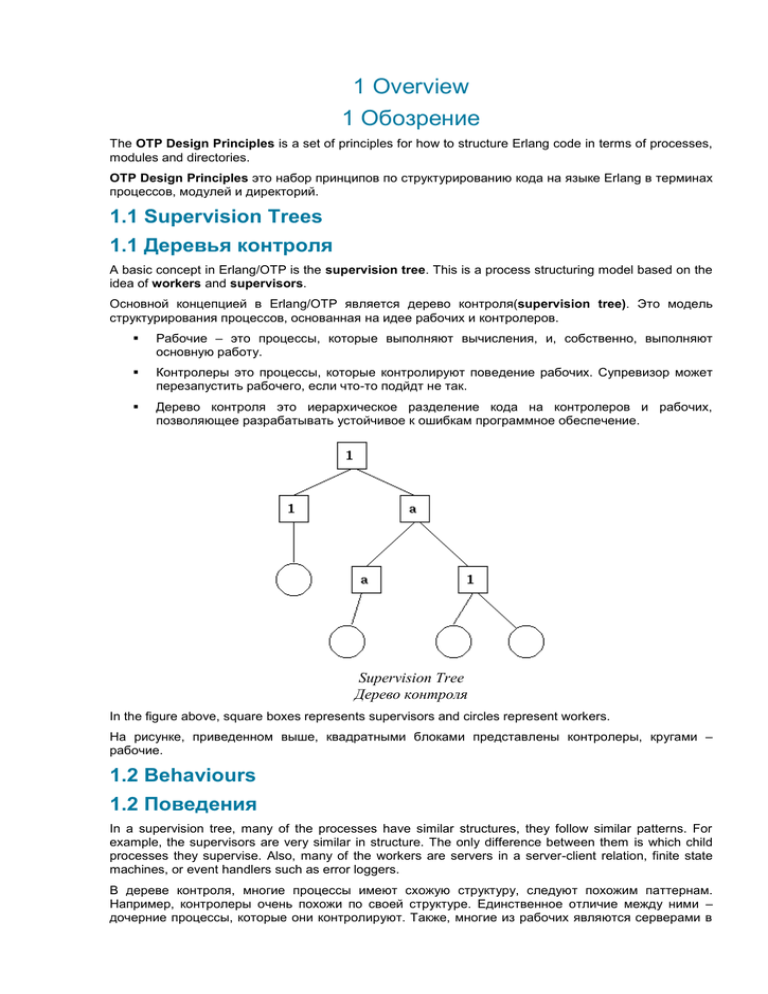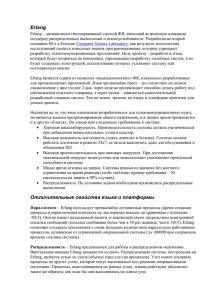1 Overview
реклама

1 Overview
1 Обозрение
The OTP Design Principles is a set of principles for how to structure Erlang code in terms of processes,
modules and directories.
OTP Design Principles это набор принципов по структурированию кода на языке Erlang в терминах
процессов, модулей и директорий.
1.1 Supervision Trees
1.1 Деревья контроля
A basic concept in Erlang/OTP is the supervision tree. This is a process structuring model based on the
idea of workers and supervisors.
Основной концепцией в Erlang/OTP является дерево контроля(supervision tree). Это модель
структурирования процессов, основанная на идее рабочих и контролеров.
Рабочие – это процессы, которые выполняют вычисления, и, собственно, выполняют
основную работу.
Контролеры это процессы, которые контролируют поведение рабочих. Супревизор может
перезапустить рабочего, если что-то подйдт не так.
Дерево контроля это иерархическое разделение кода на контролеров и рабочих,
позволяющее разрабатывать устойчивое к ошибкам программное обеспечение.
Supervision Tree
Дерево контроля
In the figure above, square boxes represents supervisors and circles represent workers.
На рисунке, приведенном выше, квадратными блоками представлены контролеры, кругами –
рабочие.
1.2 Behaviours
1.2 Поведения
In a supervision tree, many of the processes have similar structures, they follow similar patterns. For
example, the supervisors are very similar in structure. The only difference between them is which child
processes they supervise. Also, many of the workers are servers in a server-client relation, finite state
machines, or event handlers such as error loggers.
В дереве контроля, многие процессы имеют схожую структуру, следуют похожим паттернам.
Например, контролеры очень похожи по своей структуре. Единственное отличие между ними –
дочерние процессы, которые они контролируют. Также, многие из рабочих являются серверами в
клиент-серверной модели, конечными автоматами, или обработчиками событий, такими как логгер
ошибок.
Behaviours are formalizations of these common patterns. The idea is to divide the code for a process in
a generic part (a behaviour module) and a specific part (a callback module).
Поведения(Behaviours) – это формализация таких общих паттернов. Идея заключается втом,
чтобы разделить кодв процесс в общую часть (модуль поведения) и специализированную часть
(модуль обратного вызова(callback module))
The behaviour module is part of Erlang/OTP. To implement a process such as a supervisor, the user only
has to implement the callback module which should export a pre-defined set of functions, the callback
functions.
Модуль поведения является частью Erlang/OTP. Для того, чтобы реализовать процесс как
контролер, пользователю необходимо только реализовать модуль обратного вызова, который
должен экспортировать предопределенное
множество функций (функций обратного
вызова(callback functions)).
An example to illustrate how code can be divided into a generic and a specific part: Consider the following
code (written in plain Erlang) for a simple server, which keeps track of a number of "channels". Other
processes can allocate and free the channels by calling the functions alloc/0 and free/1,
respectively.
An example to illustrate how code can be divided into a generic and a specific part: Consider the following
code (written in plain Erlang) for a simple server, which keeps track of a number of "channels". Other
processes can allocate and free the channels by calling the functions alloc/0 and free/1,
respectively.
Пример продемонстрирует, как код может быть разделен на общую и специализированную части.
Предположим следующий код(написанный на чистом Erlang) для простого сервера, который
следит за некоторым количеством «каналов». Другие процессы могут создавать и уничтожать эти
каналы, вызвая функции , alloc/0 и free/1, соответственно.
-module(ch1).
-export([start/0]).
-export([alloc/0, free/1]).
-export([init/0]).
start() ->
spawn(ch1, init, []).
alloc() ->
ch1 ! {self(), alloc},
receive
{ch1, Res} ->
Res
end.
free(Ch) ->
ch1 ! {free, Ch},
ok.
init() ->
register(ch1, self()),
Chs = channels(),
loop(Chs).
loop(Chs) ->
receive
{From, alloc} ->
{Ch, Chs2} = alloc(Chs),
From ! {ch1, Ch},
loop(Chs2);
{free, Ch} ->
Chs2 = free(Ch, Chs),
loop(Chs2)
end.
The code for the server can be rewritten into a generic part server.erl:
Код сервера может быть разделен на общую часть server.erl:
-module(server).
-export([start/1]).
-export([call/2, cast/2]).
-export([init/1]).
start(Mod) ->
spawn(server, init, [Mod]).
call(Name, Req) ->
Name ! {call, self(), Req},
receive
{Name, Res} ->
Res
end.
cast(Name, Req) ->
Name ! {cast, Req},
ok.
init(Mod) ->
register(Mod, self()),
State = Mod:init(),
loop(Mod, State).
loop(Mod, State) ->
receive
{call, From, Req} ->
{Res, State2} = Mod:handle_call(Req, State),
From ! {Mod, Res},
loop(Mod, State2);
{cast, Req} ->
State2 = Mod:handle_cast(Req, State),
loop(Mod, State2)
end.
and a callback module ch2.erl:
и модуль обратного вызова ch2.erl:
-module(ch2).
-export([start/0]).
-export([alloc/0, free/1]).
-export([init/0, handle_call/2, handle_cast/2]).
start() ->
server:start(ch2).
alloc() ->
server:call(ch2, alloc).
free(Ch) ->
server:cast(ch2, {free, Ch}).
init() ->
channels().
handle_call(alloc, Chs) ->
alloc(Chs). % => {Ch,Chs2}
handle_cast({free, Ch}, Chs) ->
free(Ch, Chs). % => Chs2
Note the following:
Заметьте следующее:
The code in server can be re-used to build many different servers.
The name of the server, in this example the atom ch2, is hidden from the users of the client
functions. This means the name can be changed without affecting them.
The protcol (messages sent to and received from the server) is hidden as well. This is good
programming practice and allows us to change the protocol without making changes to code
using the interface functions.
We can extend the functionality of server, without having to change ch2 or any other callback
module.
Код server может быть использован для построения множества различных серверов.
Имя сервера, атом ch2 в этом примере, спрятан от пользователей клиентских функций.
Это означает, что имя может быть изменено без каких-либо последствий для них
Протокол (сообщения посылаемые и получаемые сервером) также хорошо спрятаны. Это
хорошая практика программирования и позоваляте нам менять протокол без изменения
кода используя функции интерфейса
Мы можем расширить функциональность server, без необходимости изменять ch2 или
любой другой модуль обратного вызова.
Code written without making use of behaviours may be more efficient, but the increased efficiency will be
at the expense of generality. The ability to manage all applications in the system in a consistent manner is
very important.
Код написанный без использования поведений может быть более эффективным, но платой за
увеличение эффективности будет потеря общности. Возможность управлять всеми приложениями
в системе одинаковым способом очень важна.
Using behaviours also makes it easier to read and understand code written by other programmers. Ad
hoc programming structures, while possibly more efficient, are always more difficult to understand.
Использование поведений делает чтение и понимание кода другими программистами легче.
Структуры Ad hoc, возможно, более эффективные, всегда сложенее понимать.
The module server corresponds, greatly simplified, to the Erlang/OTP behaviour gen_server.
Модуль server соотвествует, со значительными упрощениями, поведению gen_server из
Erlang/OTP.
The standard Erlang/OTP behaviours are:
gen_server For implementing the server of a client-server relation.
gen_fsm For implementing finite state machines.
gen_event For implementing event handling functionality.
supervisor For implementing a supervisor in a supervision tree.
Стандартными поведениями в Erlang/OTP являются:
gen_server Для реализации клиент-серверной модели взаимодействия.
gen_fsm Для реализации конечных автоматов.
gen_event Для реализации обработки событий.
supervisor Для реализации контролера в дереве контроля.
The compiler understands the module attribute -behaviour(Behaviour) and issues warnings about
missing callback functions. Example:
Компилятор понимает атрибут модуля -behaviour(Behaviour) и ругается при отсутствии
функций обратного вызова. Например:
-module(chs3).
-behaviour(gen_server).
...
3> c(chs3).
./chs3.erl:10: Warning: undefined call-back function handle_call/3
{ok,chs3}
1.3 Applications
1.3 Приложения
Erlang/OTP comes with a number of components, each implementing some specific functionality.
Components are with Erlang/OTP terminology called applications. Examples of Erlang/OTP applications
are Mnesia, which has everything needed for programming database services, and Debugger which is
used to debug Erlang programs. The minimal system based on Erlang/OTP consists of the applications
Kernel and STDLIB.
Erlang/OTP поставляется с набором компонент, каждая из которых реализует особый функционал.
Компоненты в терминологии Erlang/OTP называются приложениями(applications). Примеры
приложений Erlang/OTP являются Mnesia, которая содержит в себе все, необходимое для
программирования баз данных, и Debugger, используемый для отладки Erlang програм.
Минимальная система, основанная на Erlang/OTP состоит из приложений Kernel и STDLIB.
The application concept applies both to program structure (processes) and directory structure (modules).
Концепция приложений
директорий(модулям).
относится
и
к
структуре
программы(процессам),
и
к
структуре
The simplest kind of application does not have any processes, but consists of a collection of functional
modules. Such an application is called a library application. An example of a library application is
STDLIB.
Приложение простейшего типа не содержит ни одного процесса, а состоит из набора
функциональных
модулей.
Такие
приложения
называются
библиотечными
приложениями(library application).
An application with processes is easiest implemented as a supervision tree using the standard
behaviours.
Приложение с процессами проще всего реализовать как дерево контроля, использующее
стандартные поведения.
How to program applications is described in Applications.
Как создавать приложения описано в Applications.
1.4 Releases
1.4 Релизы
A release is a complete system made out from a subset of the Erlang/OTP applications and a set of userspecific applications.
How to program releases is described in Releases.
How to install a release in a target environment is described in the chapter about Target Systems in
System Principles.
Релиз - это полноценная система, сделанная на основе некоторого подмножества приложений the
Erlang/OTP и набора написанных пользователем приложений.
Создание релизов описано в Releases.
Как устанавливать релиз на нужную систему, описано в главе о развертывании систем.
1.5 Release Handling
1.5 Работа с релизами
Release handling is upgrading and downgrading between different versions of a release, in a (possibly)
running system. How to do this is described in Release Handling.
Работа с релизами(Release handling) это обновление или установка более старой версии релиза
на (возможно) работающей системе. Как это сделать, описано в Release Handling.
